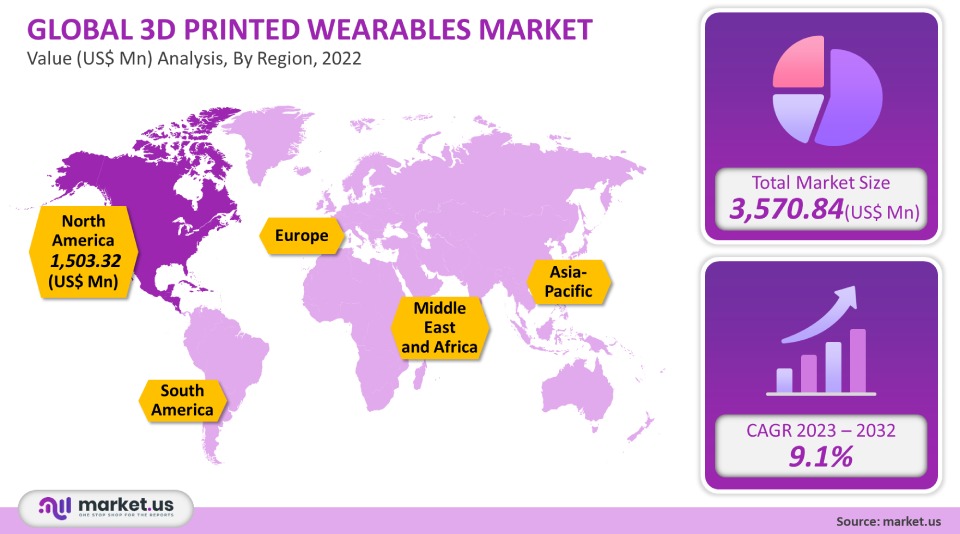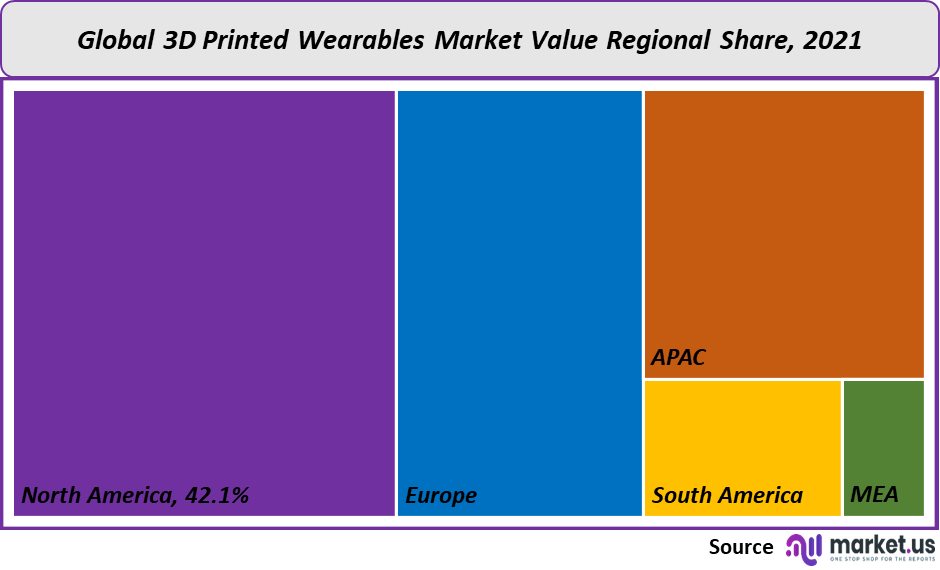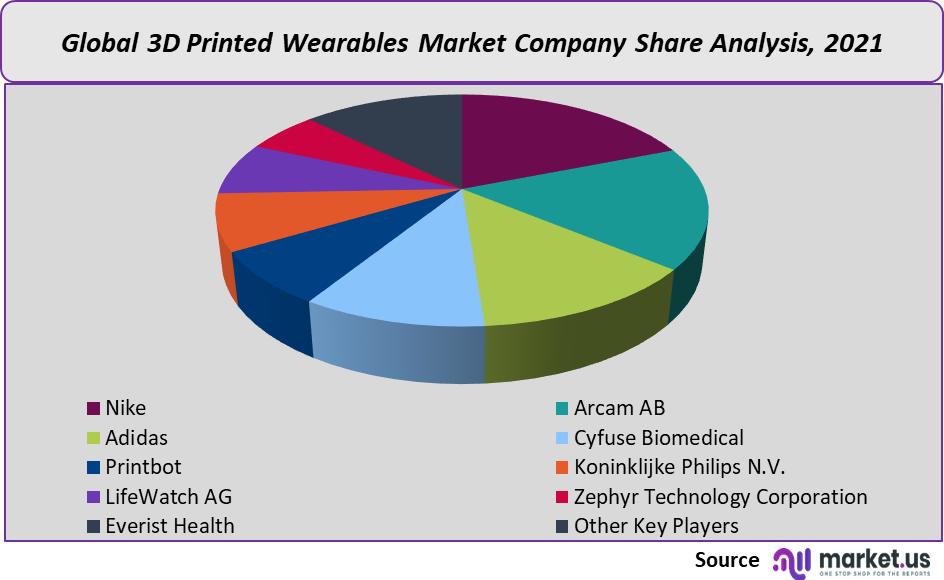Global 3D Printed Wearables Market By Product Type (Orthopedic Implants, Prosthetics, Smart Watches, Surgical Instruments, and Fitness Trackers), By End-user (Pharma and Biotech companies, Hospital, and Academic Institutes), By Region and Companies - Industry Segment Outlook, Market Assessment, Competition Scenario, Trends and Forecast 2022-2032
- Published date: Dec 2021
- Report ID: 67337
- Number of Pages: 321
- Format:
- keyboard_arrow_up
3D Printed Wearables Market Overview:
Global 3D printed wearables market accounted for USD 3,570.84 million in 2021. It is projected to grow at a 9.1% CAGR, between 2023 to 2032.
The manufacturing of medical devices and other products layer-by-layer using 3D printing technology is a key component. This market is expected to grow due to the increasing emphasis on 3D-printed wearables by manufacturers. 3D printed wearables sales will rise as the new 3D printed wearables overcome the limitations of traditional products.
Global 3D Printed Wearables Market Scope:
Product type analysis
Prosthetics accounted for 37.2% of the total revenue in 2021, which was the highest. This segment’s large revenue share can be attributed to rising chronic disease prevalence and growing demand for prosthetics implants in developing countries. Other factors that will fuel growth in this segment include an increase in the number of cases of amputation worldwide and an increase in limb loss due to cardiovascular disease.
Market growth will be further influenced by technological advancement, the increasing prevalence of vascular diseases, and the increased demand for prosthetics. There is a growing need for these devices due to the increasing use of connectivity technologies like Bluetooth, microprocessor controllers, and myoelectric. The advancements in material science have made it possible to use carbon fiber materials and thermoplastics for robotic amputation devices. This reduces both the cost and improves the overall efficiency. Other factors that will drive 3D printed wearables market growth over the forecast period include increasing demand in advanced technologically advanced countries as well as increasing awareness.

End-user analysis
According to end-users, the 37% revenue share for academic institutes was the highest at 37% in 2021. Due to the rapid increase in patient population and increased investment in R&D for 3D printed wearable devices, this is a result. Manufacturers have increased their investment in 3D printing to improve their productivity and efficiency.
This segment has seen significant growth due to a growing focus on 3D printed wearables, and a rise in R&D spending. The other segment, such as medical and surgical centers, is also expected to grow over the forecast period. This is due to an increase in demand for 3D printed apparel and a decrease in operative- and infection risk.
Кеу Маrkеt Ѕеgmеntѕ:
By Product Type
- Orthopedic Implants
- Prosthetics
- Smart Watches
- Surgical Instruments
- Fitness Trackers
By End-user
- Pharma and Biotech companies
- Hospital
- Academic Institutes
- Other End-users
Market Dynamics:
Market growth is expected to be boosted by the rising incidence of diabetes in the world. The major contributors to diabetes’ rise are antimicrobial resistance, unhealthy lifestyles, alcohol intake, smoking, and sedentary lifestyles. The CDC published the 2017 National Diabetes Statistic Report. It revealed that more than 100 million Americans had diabetes or prediabetes. The WHO also reported that diabetes was responsible for approximately 2 million deaths worldwide in 2016.
The WHO estimates that chronic diseases, such as diabetes, heart disease, and respiratory disorders, account for almost 60% of all deaths worldwide. They also account for 44% of the global disease burden. These numbers are expected to rise to 60% and 73% by 2021, respectively. It is likely that the increasing number of chronic conditions will increase the demand for effective treatments.
Additive Manufacturing is also known as 3D Printing. It has the potential to offer cost-effective ways to create complex and custom medical parts & components, such as organs and cranial implants. Tissues and prosthetics are some of the other benefits.To overcome the statistical challenges that arise from the integration of high-throughput genomic and biomedical data, it is necessary to reduce costs and improve integration methods. In order to achieve optimal results in simulation and modeling, there are also errors caused by the constant addition of genomes to public sequence databases.
Market growth will be limited by a shortage of computer- and biology-trained scientists over the forecast period. Scientists with special strengths in medicine, mathematics, and biology are in high demand. Pharmaceutical companies need scientists who can perform backward investigations because of the increasing demand for data.
Regional Analysis:
North America was the dominant market for 3D printed wearables in 2021, accounting for 42.1% of the total revenue. It is expected to maintain its dominance in the future. This is due to the rapid development of 3D-printed wearables to meet the growing need for high-quality healthcare and strong R&D and promotion of new therapies. North America is the leading manufacturing center for high-end, reliable, and complex 3D printed medical devices and wearables. This will drive the market growth in 3D printed wearables.
The U.S. healthcare system includes multispecialty hospitals and clinics. This is due in part to the high per capita income and consumer awareness of the new technologies. There are many 3D-printed wearables companies in the country with strong distribution networks.Germany is home to one of the most advanced and oldest public healthcare systems. It has a robust national social insurance system, which includes marginalized communities. This has allowed for better access to more advanced treatments. It is a great place to invest because of its strong government support and the presence of large and small 3D printing companies in Germany. Fraunhofer Additive Manufacturing Alliance, for example, brings together 18 Fraunhofer institutes from across the country to address issues related to 3D printing as well as the entire value chain.
The market is expected to be driven by rapid technological advances and the rising need for 3D printed, wearable devices. Due to the growing healthcare sector in the region, many medical device manufacturers are now focusing their efforts on this market. The market is also growing due to rising R&D spending and increasing investments in 3D printing.

Key Regions and Countries covered іn thе rероrt:
- North America
- US
- Canada
- Mexico
- Europe
- Germany
- UK
- France
- Italy
- Russia
- Spain
- Rest of Europe
- APAC
- China
- Japan
- South Korea
- India
- Rest of Asia-Pacific
- South America
- Brazil
- Argentina
- Rest of South America
- MEA
- GCC
- South Africa
- Israel
- Rest of MEA
Market Share & Key Players Analysis:
Companies are pursuing mergers and acquisitions to increase their product range and manufacturing capabilities and differentiate themselves from the rest.

Маrkеt Кеу Рlауеrѕ:
- Nike
- Arcam AB
- Adidas
- Cyfuse Biomedical
- Printbot
- Koninklijke Philips N.V.
- LifeWatch AG
- Zephyr Technology Corporation
- Everist Health
- Other Key Players
For the 3D Printed Wearables Market research study, the following years have been considered to estimate the market size:
Attribute Report Details Historical Years
2016-2020
Base Year
2021
Estimated Year
2022
Short Term Projection Year
2028
Projected Year
2023
Long Term Projection Year
2032
Report Coverage
Competitive Landscape, Revenue analysis, Company Share Analysis, Manufacturers Analysis, Volume by Manufacturers, Key Segments, Key company analysis, Market Trends, Distribution Channel, Market Dynamics, COVID-19 Impact Analysis, strategy for existing players to grab maximum market share, and more.
Regional Scope
North America, Europe, Asia-Pacific, South America, Middle East & Africa
Country Scope
United States, Canada and Mexico, Germany, France, UK, Russia and Italy, China, Japan, Korea, India and Southeast Asia, Brazil, Argentina, Colombia etc.Saudi Arabia, UAE, Egypt, Nigeria and South Africa
Frequently Asked Questions (FAQ)
Q: What is the size of the 3D Printed Wearables market in 2021?The 3D Printed Wearables market size is US$ 3,570.84 million in 2021.
Q: What is the projected CAGR at which the 3D Printed Wearables market is expected to grow at?The 3D Printed Wearables market is expected to grow at a CAGR of 9.1% (2023-2032).
Q: List the segments encompassed in this report on the 3D Printed Wearables market?Market.US has segmented the 3D Printed Wearables market by geographic (North America, Europe, APAC, South America, and Middle East and Africa). By Product Type, market has been segmented into Orthopedic Implants, Prosthetics, Smart Watches, Surgical Instruments, and Fitness Trackers. By End User, the market has been further divided into Pharma and Biotech companies, Hospital, and Academic Institutes
Q: List the key industry players of the 3D Printed Wearables market?Nike, Arcam AB, Adidas, Cyfuse Biomedical, Printbot, Koninklijke Philips N.V., LifeWatch AG, Zephyr Technology Corporation, Everist Health, and Other Key Players engaged in the 3D Printed Wearables market.
Q: Which region is more appealing for vendors employed in the 3D Printed Wearables market?North America accounted for the highest revenue share of 42.1%. Therefore, the 3D Printed Wearables industry in North America is expected to garner significant business opportunities over the forecast period.
Q: Name the key areas of business for 3D Printed Wearables?The U.S., Canada, U.K., Germany, Italy, Spain, France, China, India, Japan, South Korea, Australia, Brazil, Mexico, Argentina, South Africa, Saudi Arabia, UAE, are key areas of operation for 3D Printed Wearables Market.
Q: Which segment accounts for the greatest market share in the 3D Printed Wearables industry?With respect to the 3D Printed Wearables industry, vendors can expect to leverage greater prospective business opportunities through the prosthetics segment, as this area of interest accounts for the largest market share.
![3D Printed Wearables Market 3D Printed Wearables Market]()
- NIKE, Inc. Company Profile
- Arcam AB
- Adidas
- Cyfuse Biomedical
- Printbot
- Koninklijke Philips N.V.
- LifeWatch AG
- Zephyr Technology Corporation
- Everist Health
- Other Key Players
- settingsSettings
Our Clients
|
Single User
$5,999
$2,999
USD / per unit
save 50% |
Multi User
$7,999
$3,499
USD / per unit
save 55% |
Corporate User
$12,999
$4,499
USD / per unit
save 65% | |
|---|---|---|---|
| e-Access | |||
| Data Set (Excel) | |||
| Company Profile Library Access | |||
| Interactive Dashboard | |||
| Free Custumization | No | up to 10 hrs work | up to 30 hrs work |
| Accessibility | 1 User | 2-5 User | Unlimited |
| Analyst Support | up to 20 hrs | up to 40 hrs | up to 50 hrs |
| Benefit | Up to 20% off on next purchase | Up to 25% off on next purchase | Up to 30% off on next purchase |
| Buy Now ($ 2,999) | Buy Now ($ 3,499) | Buy Now ($ 4,499) |









